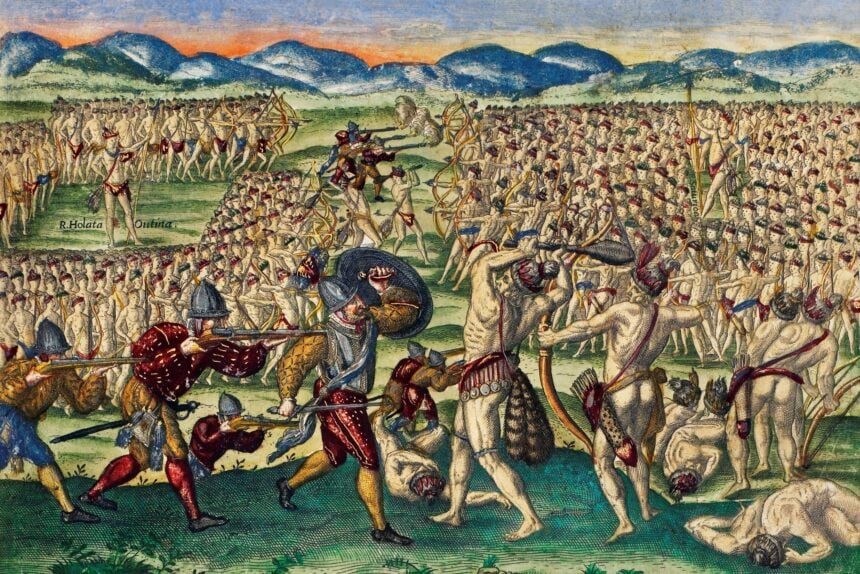Joseph Cotto, a coparticipant on podcasts with me, has self-published a book, Eye for an Eye, which deals with a subject that most American historians may never have encountered. He examines a group of 16th-century explorers and settlers who, as early as 1562, created a settlement, Charlesfort, on Parris Island, South Carolina. This settler group was made up of Huguenots (French Protestants) who, because of the hardship they incurred in the New World, soon sailed back to France. Another Huguenot expedition left the following year, and this one established a colony, Fort Caroline, near what is now the city of Jacksonville.
Unfortunately, the would-be settlers ran into a larger Spanish presence in Florida, and it wasn’t long before Spanish troops wiped out much of the French settlement, most disastrously in the long-noted massacre at Matanzas Inlet. This fate was avenged in 1568, when a French commander, Dominique de Gourgues, in alliance with surrounding Indian tribes, massacred the Spanish garrison then occupying Fort Caroline. But since the Spaniards continued to occupy Florida into the 19th century, de Gourgues’s victory—as much as Joseph Cotto might celebrate that particular event—did not significantly change the political landscape.
The reason that French Protestants, who typically came from the nobility and merchant class, wanted to establish a New World colony was to escape the religious war then raging in France. The leader who planned this exodus was Admiral of France Gaspard de Coligny, a Protestant nobleman who would die in the Saint Bartholomew’s Day Massacre, of August 1572. Along with other Protestant dignitaries, Coligny fell in this bloodbath as the victim of an assassination by the pro-Spanish faction in French royal politics.
Cotto does not pretend to be producing dispassionate history in his gripping narrative. He is clearly on the side of the Huguenots in France and in Florida; and he treats the Spaniards in the dualistic fashion of 19th-century English Whig historians, who railed against the Spanish Catholic enemies of Anglo-Saxon freedoms. Lest we miss the point, the author repeatedly reiterates which side he is rooting for.
Although one could cite examples of intolerance on both sides of the religious wars of the 16th and 17th centuries, Cotto does make a valid point about the struggle between the Spaniards and the French in northern Florida. The two sides developed strikingly different relations with the indigenous populations. The French Protestants worked to build bridges to the Timucuan Indians, who were abundantly present in that area. The Spaniards, by contrast, as was their practice, tried to conquer these Amerindians. Unlike the French, who made no effort to proselytize, the Spaniards were intent on Christianizing those Indians they spared. As a result of these differing approaches to intergroup relations, the Huguenots gained far more support among the Timucuans, who were easily rallied in 1568 to support de Gourges’s revenge on the Spaniards.
Despite these sporadic successes, the French were never able to supplant the Spaniards as the main European colonizers in Florida. The Spaniards settled St. Augustine in 1565 and would remain the dominant colonial power in Florida until 1763. Then the colony went to Britain for 20 years before being returned in 1783 to Spain, in the Treaty of Paris. The American government would then buy this tropical, or semi-tropical, territory from Spain in 1821, and Florida became a state in 1845, only to secede in 1861 with the other Southern States.
Needless to say, the large Spanish-speaking population of the state has almost nothing to do with onetime Spanish ownership of the territory. Most of these more recent immigrants arrived in Florida after it came under American control. And one would have to look hard now to find descendants of the Huguenot travelers who settled there in the 1560s. The former French settlement in Floridian territory had to be rediscovered, which is exactly why Cotto wrote his book.
Image: Timucuan leader Olata Ouae Utina defeats the Potano tribe with the help of French soldiers. Theodor de Bry, illustration from Grand Voyages, 1596. (Rawpixel / via Wikimedia Commons, CC BY-SA 4.0)

Leave a Reply